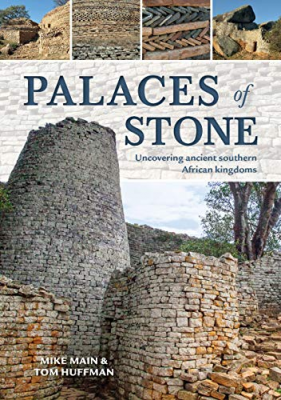Book: Palaces of Stone

Palaces of Stone, by Tom Huffman and Mike Main, published by Struik Travel & Heritage (imprint of Penguin Random House South Africa (Pty) Ltd), 2021
Across southern Africa are more than 460 remarkable stone palaces - some small, others rambling, but many are astonishing. All are the legacy of kingdoms past. Some, such as Great Zimbabwe, Khami in Botswana and Mapungubwe in South Africa, are famous world heritage sites, but the majority are unknown to the general public, unsung and unappreciated.
Some of the most compelling aspects of post-1994 Southern Africa are the ways in which academics are illuminating historical narratives through rigorous archaeology - to ensure scrupulous scientific dating - but also using the interpretive help of an arsenal of new technical tools. These factors, amongst others, have transformed African archaeology into one of the most vibrant of 21st century knowledge frontiers.
And, because long-suffering South Africans, for almost the entire 20th century, were subjected to gerrymandered versions of 'history' comprised of outright whoppers, sly omissions and half-truths, a primary audience for factual books on important historical topics is South Africans themselves. That this work is beautifully written, easy to read and magnificently illustrated, not to mention compact and portable, means that it should be a standard on every African bookshelf. More than ever, in 2021, facts matter.
However, the spell-binding subject matter - a detailed and accessible yet scholarly discussion of southern Africa's pre-colonial history of successive wealthy trade-based inland city-states - means that a wide international audience will be equally captivated. Many global citizens will know, even if hazily, of Southern Africa's spectacular 'lost city', the impressive citadel and sprawling mass of surrounding ruins known as 'Great Zimbabwe', which is the largest ancient kingly 'palace' of the book's title.
Located some 300 km from Bulawayo, Zimbabwe's southerly 'second city', the long-abandoned 14th/15th century complex of Great Zimbabwe, once home to some 18 000 souls, was awarded UNESCO World Heritage Site status in 1986. But what has become clear in the years since both Zimbabwean independence and South Africa's political transition, is how many other ancient city-state settlements, in a belt stretching from eastern Botswana to the Mozambican coast came to prominence, and then faded from view.
But how did these settlements originate? Why did they occur in this pattern? And why were they abandoned?
In pre-colonial times, large parts of Africa's interior were no-go zones, especially for cattle-owning societies, due to diseases that afflicted both people and stock animals. However, there were notable exceptions to such inhospitable regions, and these occurred where Africa's internal shield-like plateau was elevated. At altitude, neither disease-bearing mosquitos nor the tsetse fly, whose bite took a terrible toll on cattle, held sway. It was here that a succession of sophisticated trade focused city-states thrived, with connections to the brilliant age of Arab scholarship, trade entrepots of the Levant, and the Orient. University of the Witwatersrand archaeologist Emeritus Tom Huffman, and co-author Mike Main explain:
'It is an extraordinary tale of impressive feats of architecture, long-distance travel, global trade and complex political and administrative forms of organisation. But above all, it offers another perspective on what we once assumed were the vast empty spaces of Africa past, revealing instead a hinterland that hummed with activity - mining, commerce, transportation, farming and hunting'.
To date, an astonishing tally of 566 such settlements of varying dates, many close to ancient Botswanan gold workings, have been documented on the southern African 'Highveld' - one of the most important of which is another World Heritage Site (2003) located inside South Africa, called Mapungubwe. First visited by academics in the 1930s, although it lacked the magnificent dry-stone walling of Great Zimbabwe, untouched Mapungubwe was to prove the 'Rosetta Stone' that unlocked the secrets of a fabulous past.
Mapungubwe is significantly earlier than Great Zimbabwe. In its ascendent in the early 1200s, it was located at the confluence of two rivers, the Shashe and the Limpopo. This, plus its altitude, fostered both intensive cultivation and cattle keeping. If, however, the district was welcoming to people, being well watered, it was also home to vast herds of both plains game - but also enormous herds of elephant.
The other half of this enthralling equation relates to the ancient tradition of Middle Eastern dhows sailing the East African coast, a 1000-year-old commerce between the Arab and African worlds. With ivory as a high-prized trade item, from early times, these coastal visitors also learned about the significant quantities of gold produced by the skilled metallurgists of the interior.
Finding little domestic use for the soft metal, economic historians have estimated that the ancient mine operators exported vast quantities of gold - the equivalent of US$ 250 million over one 150- year period - as well as a seemingly limitless supply of ivory from Africa's abundant herds. The trade was operated by busy bearer caravans thronging to and from the coast, where Africa's natural bounty was exchanged for manufactured goods, textiles and beads, using satellite waystations extending from the westerly political and minerals heartland to the coast.
Work at Mapungubwe revealed it to be the earliest - the 'type specimen' - in a succession of entirely new, highly organised polities ruled over by hierarchical kingly figures operating efficient, labour-divided societies. Collectively known as 'Zimbabwe Culture' city-states, these complex societies were eventually destabilised by internal strife, the advent of the colonial presence, and climate change.
One of the rewarding aspects of this book is how it offers a practical 'how to' with regards to historical method. The effortlessly phrased text 'tells the story', sets out conclusions, and buttresses it all with tightly researched evidence - a process that lures one into a riveting armchair 'Indiana Jones' style process of discovery. Stylish, as it should be for such a topic, this book supplies the desperately overdue factual back-story on a satisfying list of critical topics: an in-depth analysis of the architecture; discussion of pre-colonial African governance; the linkages of these African kingdoms with Europe's 17th century expanding spice empires; and the laughably bad - and the good - of colonial-era-studies.
This book should however be at hand as one makes the absorbing 'trek' to physically explore either Mapungubwe or Great Zimbabwe, both of which have recommended on-site museums. Today, at these long abandoned, brooding palaces, rock pythons bask on the ruined stone terraces and baboons stand watch over one of earth's most ancient vistas: northwards into an African hinterland almost as old as the planet itself.
Travel Advisory: As the Covid vaccine rollout proceeds, visits to either Great Zimbabwe or Mapungubwe become more feasible. Self-drive access of a single party using a hire car and travelling in a 'bubble' works well. The region's preference for low density personalized experiences over mass travel makes it an appealing and practical post-Covid travel choice.
Palaces of Stone, by Tom Huffman and Mike Main, published by Struik Travel & Heritage (imprint of Penguin Random House South Africa (Pty) Ltd), 2021


















